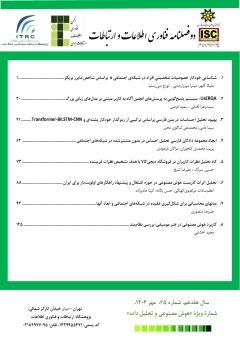مدل های محاسباتی برای شکلگیری عقیده در شبکههای اجتماعی و ابعاد آنها
محورهای موضوعی : ICT
1 - پژوهشگاه ارتباطات و فناوری اطلاعات
کلید واژه: شکلگیری عقیده, انتشار عقیده, پویایی عقیده, مدلسازی, علوم اجتماعی محاسباتی,
چکیده مقاله :
شکلگیری عقیده در شبکههای اجتماعی به بررسی پویایی تغییر عقیدة افراد تحت تأثیر سایرین و در نتیجه تغییر عقیده در کل جامعه میپردازد. شکلگیری عقیده از مباحث علوم اجتماعی است، اما برخی مدلهای محاسباتی برای آن ارائه شدهاند که بررسی پویایی عقیده و نحوة ایجاد وضعیتهایی مانند اجماع، دوقطبی/چندقطبی شدن، و یا اختلاف عقاید افراد جامعه در شرایط مختلف را با روشهای محاسباتی توجیه نمایند. با روند روبهرشد شبکههای اجتماعی برخط و با توجه به سرعت و سهولت تولید و انتشار محتوا در این شبکهها، انتخاب و استفاده از مدل شکلگیری عقیدة مناسب از اهمیت زیادی برخوردار است. در این پژوهش ضمن مرور مدلهای شکلگیری عقیده، ابعاد مختلفی که این مدلها را نسبت به یکدیگر متمایز میکنند، استخراج شده و بر اساس این ابعاد، جایگاه مدلهای شکلگیری عقیده نیز مشخص شده است. این ابعاد عبارتند از: 1) فضای عقیده، 2)گسسته/پیوسته بودن زمان 3) شبکة تعامل، 4) محدودیت تعامل، 5) میزان تأثیر، 6) وابستگی به زمان و 7) خطی/غیرخطی بودن. بهعلاوه، شرایطی را در مدلهای شکلگیری عقیده می توان در نظر گرفته که روی پویایی و نتیجه تأثیرگذار است، شامل 1) همگونی/ناهمگونی جامعه، 2) تعداد ابعاد فضای عقیده، 3) تصور اولیة جامعه، 4) قطعی یا نویزی بودن مدل. نتایج این پژوهش به پژوهشگران حوزة شکلگیری عقیده کمک میکند مدل شکلگیری عقیدة مناسب با توجه به شرایط و ویژگیهای موضوع مورد بررسی انتخاب کنند و حتی در صورتی که نیاز به گسترش مدلهای شکلگیری عقیده است، چه ابعاد و ویژگیهایی را مد نظر قرار دهند.
Opinion formation is a propagation process in social networks, examining the dynamics of people's opinion dynamics under the influence of others. Several computational opinion formation models have been proposed to study the dynamics of opinion and the process of creating situations such as consensus, bipolarity/multi-polarization, or the diversity of opinions in a society. Due to the growing trend of online social networks and considering the speed and convenience of producing and publishing content in these networks, an appropriate opinion formation model should be used in related studies. This study surveys the major opinion formation models and introduces a set of dimensions distinguishing opinion formation models. These dimensions are comprised of 1) opinion space, 2) discrete/continuous time, 3) interaction network, 4) interaction limitation, 5) degree of influence, 6) time dependency, and 7) linearity of model. Moreover, some conditions could be considered on the models that affect opinion formation model, including 1) homogeneity/heterogeneity of interacting people, 2) the number of dimensions of opinion space, 3) first impression, and 4) deterministic/noisy modeling. The results of this study help the researchers in the field of opinion formation to choose the appropriate opinion formation model according to the conditions and characteristics of the subject under investigation, and even to expand opinion formation models, if necessary.

